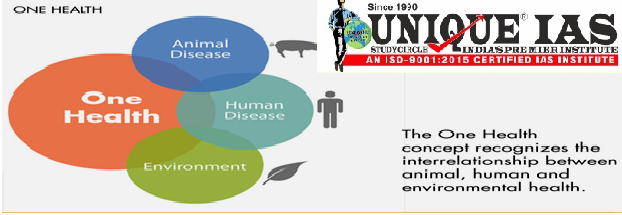One Health
One health recognizes that the health of people is closely connected to health of animals and atmosphere.
The Need of One Health-
The concept of One Health can be effectively executed for reducing incidence of emerging zoonotic threats like COVID-19 .- The diseases, which “spillover” from animals to humans are referred to as zoonotic diseases .-They zoonotic threats represent more than 60% of emerging infectious diseases worldwide.
Human population are growing and expanding into new geographic area. as a result more people live in close contact with wild and domestic animal are both livestock and pets.
animal play an important role in our live whether for food, fiber, travel, sport, education or companionship.
close contact with animals and their atmosphere provides more opportunities for diseases to pass between animal and people.
The earth has experienced changes in climate and land use and such as deforestation and intensive farming practices. disruptions in environmental condition and habitat can provide new opportunities for diseases pass to animals.
The movement of people, animals, and animal products has increased from international travel and trade. as a result diseases can spread quickly across borders and around globe.
These changes have led to the spread of existing or known and new or emerging zoonotic diseases, which are diseases that can spread between animal and people. examples of zoonotic diseases include:
-
Rabies
-
Salmonella infection
-
West Nile virus infection
-
Q Fever (Coxiella burnetii)
-
Anthrax
-
Brucellosis
-
Lyme disease
-
Ringworm
-
Ebola
-
Animals can sometime serve as early warning signs of potential human illness for example birds oftentimes die of west nile virus before people in the same area get sick with west nile virus infection.
The infection of plants by pathogens can have serious consequences on plant health, human health can be affected by one of the several ways.
Viruses, bacteria and fungi that infect plants do not usually cause infection in humans however they may react with the immune system of humans and induce a clinical symptom.
How does a One Health approach work?
Successful public health interventions require the Co-operation of human, animal, and environmental health partners. Professionals in human health (doctors, nurses, public health practitioners, epidemiologists), animal health (veterinarians, paraprofessional, agricultural workers), environment (ecologists, wildlife experts), and other areas of expertise need to communicate, collaborate on, and coordinate activities.
Other relevant players in a one health approach could include law actuation, policymakers, agriculture, communities, and also pet owners.
no one person, organization or sector can address issue at the animal human environment interface alone.
by promoting co-partnership across all sectors, a one health approach can achieve the best health outcomes for people, animals and plants in a shared atmosphere.
One Health in India-
-In the 1950s, the one health approach helped discover the source of Kyasanur Forest Disease , a highly dangerous haemorrhagic fever(damage of blood vessels and organs)more threatening than COVID-19.




.jpg)
.jpg)
.jpg)
.jpg)
.jpg)




